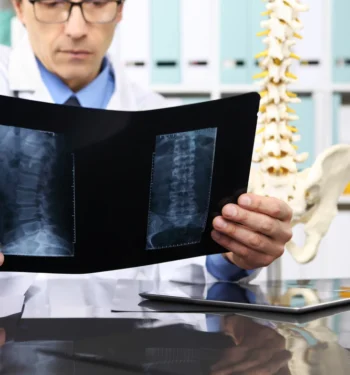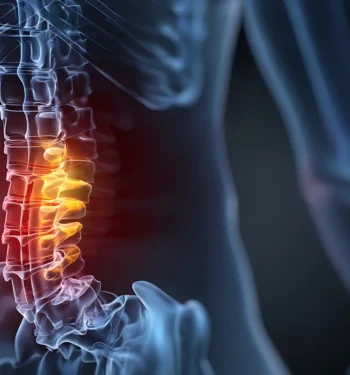
Introduction to Spinal Stenosis and Exercise
Spinal stenosis is a condition that affects countless individuals, causing the spaces within the spine to narrow and put pressure on the nerves travelling through the spine. The most common symptoms include persistent back pain, leg pain, numbness, and sometimes weakness in the arms or legs. These symptoms can make simple daily activities challenging, reducing quality of life and independence. Understanding this condition can feel overwhelming, but knowledge is the first step toward a more comfortable path forward. NOTE: If you are recovering from spinal stenosis surgery, please reach out to your care team for your specific exercise program.
What Is Spinal Stenosis?
Spinal stenosis progresses gradually and often develops with age, but it can also be caused by injuries, arthritis, or congenital spine conditions. The narrowing occurs most often in the lumbar (lower back) or cervical (neck) regions of the spine. Symptoms can range from mild tingling and discomfort to severe pain and mobility limitations. Knowing what to watch for and seeking timely medical advice are essential in preventing further complications and improving your day-to-day comfort.
Why Is Exercise Important for Spinal Stenosis?
Exercise plays a powerful role in managing spinal stenosis. If you have not had surgery for spinal stenosis, targeted movements can gently increase flexibility, strengthen the muscles that support your spine, and even reduce pressure on affected nerves. Many people find that when combined with medical guidance, exercise is one of the key tools for back pain relief and for reclaiming mobility without surgery. Not only does regular movement help you physically, it also boosts your mood and confidence, reminding you that strength and comfort are possible.
If you have spinal stenosis, it is critically important to consult your physician before starting any new exercise program. A spine specialist at a trusted center like Goodman Campbell can guide you through safe, effective exercises tailored to your specific needs. With expert support, you can safely build a routine that addresses your symptoms, helps you regain confidence, and enriches your daily life. If you suspect you have spinal stenosis or are ready to take the next step toward managing your spinal stenosis progression, request an appointment at Goodman Campbell. Their comprehensive care can help you manage spinal stenosis and restore your quality of life.
What Is the Single Best Exercise for Spinal Stenosis?
There is no single best exercise for spinal stenosis, but the knee-to-chest stretch is an excellent option because it gently stretches and relieves pressure on the lower back. This stretch increases flexibility, promotes circulation, and can help open up the spaces around the lumbar nerves, providing notable relief for many patients with lumbar foraminal stenosis. The simplicity, adaptability, and low risk profile of this exercise make it a top choice for people of all ages and most mobility levels, especially seniors or those experiencing severe discomfort. However, because each case of spinal stenosis is unique, it is essential to consult your doctor before starting any exercise, especially after surgery.
Which Exercise Targets Lumbar Foraminal Stenosis Most Effectively?
When dealing specifically with lumbar foraminal stenosis, exercises that promote gentle flexion of the spine, such as the knee-to-chest stretch, are particularly effective. This exercise helps by stretching the muscles in the lower back and increasing the spaces through which the nerves travel. To perform it, lie on your back with both feet flat on the floor, slowly bring one knee up towards your chest while keeping the other foot flat, and gently hold the position for 15-30 seconds before switching sides. Practice this 2–3 times on each side. Always maintain a slow and steady motion, breathing deeply to support relaxation and maximize the benefits.
How Do These Exercises Improve Flexibility in the Lower Back?
The magic of spinal stenosis workouts lies in their ability to release tension, elongate the spinal muscles, and promote gentle movement in areas often stiffened by pain or inflammation. Enhanced flexibility leads to a greater range of motion, allowing you to move more comfortably throughout daily activities and experience less discomfort. Over time, regular, guided exercise can strengthen supportive muscles, further stabilizing the spine and contributing to back pain relief.
Modifications for Various Levels of Mobility
If you are elderly or have limited mobility, adaptations such as performing knee-to-chest stretches in a seated or supported position can help you participate safely. Your care team might recommend that you use a sturdy chair or a cushion for extra support, always moving within your comfort zone. You may be instructed to start with shorter hold times and fewer repetitions, gradually increasing as you gain confidence and strength with physician guidance. These modifications ensure that everyone can benefit from exercise while minimizing the risk of injury or discomfort.
Remember: Before launching any new exercise routine — even simple stretches — it is crucial to talk to your doctor, who can refer you to a physical therapist and Goodman Campbell. There, your comprehensive spine care team can tailor an exercise prescription to your specific needs and guide you toward the relief and mobility you deserve. Your journey toward better back health is supported every step of the way.
What Are the Five Best Exercises for Spinal Stenosis?
The following five exercises are commonly recommended by experts for their ability to optimize mobility improvement, promote healing, and support a better quality of life — even as we age. If you are experiencing spinal stenosis symptoms and have not had surgery for your condition, talk to your spine specialist about the value of integrating any of these into your routine.
1. Pelvic Tilt
A pelvic tilt begins with the person lying on their back with knees bent and feet flat on the floor. They gently tighten their abdominal muscles to flatten their lower back against the floor, holding this position for five seconds; then they slowly release. The pelvic tilt is often repeated 10 times to strengthen core stability, relieve pressure on the spine, and enhance posture.
2. Knee-to-Chest Stretch
For this exercise, the person lies on their back, brings one knee toward their chest, and gently holds it with both hands for 15–30 seconds. Then they switch legs and repeat. For increased benefit, they might draw both knees to their chest together. This stretch alleviates lumbar stiffness and provides gentle decompression.
3. Seated Lumbar Flexion
Seated on a sturdy chair with feet flat on the floor, the person leans forward slowly, allowing their hands to reach toward their ankles or the floor without causing pain. They hold for 5–10 seconds and then slowly sit upright. This movement opens up the space around the spinal nerves and can bring rapid relief from tension.
4. Cat-Camel Stretch
This position begins on hands and knees. The person gently arches their lower back upward (like a scared cat), then slowly sinks their belly down as they look slightly up (like a camel). This cycle is repeated 10 times. This exercise increases spinal mobility and provides a soothing stretch through the lower back muscles.
5. Standing Lumbar Flexion
While standing with feet hip-width apart, the person gently bends forward at the hips to touch their toes or as far as they comfortably can. They let their arms and head hang, allowing gravity to aid the stretch, holding for 20 seconds, and then slowly return upright. This exercise should only be carried out with a spine specialist’s approval. It is particularly effective for those seeking greater flexibility and mild decompression in everyday settings.
Adaptations for Elderly Individuals or Those With Limited Mobility
Every individual’s abilities are unique, and modifications are often necessary to ensure comfort and safety. For example, performing stretches on a bed instead of the floor, using cushions for extra support, or limiting the range of motion are all extra accommodations. Chairs, railings, or the assistance of a loved one can help provide the confidence and balance needed to complete these movements. Remember, each exercise is meant to inspire hope and foster gradual transformation — never to cause pain.
Take the next step toward reclaiming your vitality. Request an appointment at Goodman Campbell to initiate a workup and diagnosis, which our care team will use to put you on the right exercise path. For spinal stenosis patients who haven’t had surgery, a recommended routine often includes physical therapy and a tailored home exercise program for symptom management.
How Do These Exercises Help Relieve Symptoms?
Adopting simple, targeted exercise routines is one of the most encouraging ways to take control of your healing journey with spinal stenosis. Exercises should be thoughtfully designed to gently stretch and strengthen the muscles supporting your spine, which can relieve nerve compression and reduce pain. By focusing on core mobility improvement and flexibility, you may experience a significant reduction of chronic discomfort, as well as improvements in your ability to perform daily activities that are meaningful to you. Always remember, before beginning any exercise plan, ask your doctor about Goodman Campbell to ensure safety and personal adaptation.
While medications and procedures have their place, daily movements that target the lower back can actually address some root causes of spinal stenosis symptoms. These movements decrease stiffness, increase blood flow, and can help restore your confidence in your body’s abilities. For individuals who are elderly or have restricted mobility, adaptations for the five best exercises mean you can participate at your own pace while pursuing better health and independence.
What Is the Cobra Pose for Spinal Stenosis?
Cobra pose, known in yoga as Bhujangasana, is a gentle backbend that can help stretch and strengthen the muscles of your lower back, which may be beneficial for some patients with spinal stenosis. This pose involves lying on your stomach and slowly lifting your chest upward, creating a mild extension in the lumbar region. When practiced safely and thoughtfully, cobra pose can increase flexibility, relieve tension, and improve overall back health. However, it is essential to consult your healthcare provider before adding this or any new exercise to your routine, especially if you have spinal stenosis.
How Can Cobra Pose Be Performed Safely for Those With Spinal Stenosis?
To perform cobra pose safely, a person begins lying flat on their stomach with their legs extended and the tops of their feet pressing into the floor. They place their hands beneath their shoulders, keeping their elbows close to their body. As they inhale, they gently press through their hands and slowly lift their chest a few inches off the ground, using the strength of their back rather than pushing with their arms. This pose is held for several breaths as the person keeps their lower ribs on the floor and neck in a neutral position. They then lower back down with an exhale, and repeat as their comfort allows. For spinal stenosis patients whose spine specialists have recommended cobra pose, they must avoid overextending their back or forcing the movement.
What Precautions Should People Take With Cobra Pose and Spinal Stenosis?
While cobra pose can offer gentle lumbar extension and relief, it is not suitable for everyone with spinal stenosis. If a person’s symptoms worsen with back extension or if they feel sharp or radiating pain, they should discontinue the pose immediately. Those with severe lumbar foraminal stenosis or advanced cases should avoid deeper backbends and prioritize gentle, pain-free movement. Before introducing cobra pose or any lumbar extension stretches, always consult with your doctor or a physical therapist who understands your medical history, such as a Goodman Campbell specialist.
Tips for Recognizing if Cobra Pose Is Appropriate for You
If you are considering talking to your spine specialist about cobra pose, ask them about starting with a very modified version, perhaps only propping up on your elbows in the “baby cobra” position. Your care team will likely ask you to assess how your back and legs feel during and after the stretch — is there increased tightness, tingling, or numbness? Is your pain relieved or aggravated? Any increase in discomfort signals that this pose may not be appropriate for you at this time. Remember, every patient’s spine is unique, and what works for one person may not work for another.
If you are interested in incorporating stretches and poses like cobra into your spinal stenosis care, consult your doctor about Goodman Campbell to ensure your exercise program is safe and personalized to your needs.
What Aggravates Spinal Stenosis? Exercises to Avoid
Spinal stenosis symptoms can be aggravated by certain movements and activities that place additional stress or pressure on the spine, particularly in the lower back region. Loading the back with high-impact or repetitive motion exercises, excessive arching, or spending prolonged periods in positions that compress the spine can increase nerve irritation and worsen the pain. Understanding and recognizing these aggravators empowers patients and their families to make safer and more productive choices for their health and comfort.
The most common triggers for worsening stenosis symptoms include backward bending motions, such as hyperextension of the back, and any activity that forces you into an upright or arching posture for long stretches of time. Activities including running, jumping, heavy weightlifting, and certain yoga poses that focus on deep back bends may increase pressure within the spinal canal. Additionally, high-impact sports or sudden, jerky movements may further compress already-narrowed spaces, causing sharp or radiating pain, numbness, and even weakness in the legs.
Which Exercises Should You Avoid With Spinal Stenosis?
It is important for individuals with spinal stenosis to avoid exercises that encourage hyperextension (arching backwards) and compressive loading, especially without proper support and supervision. Standard sit-ups, back extensions from a prone position, toe-touches, and certain strength training maneuvers (e.g., heavy deadlifts or squats with improper form) can all place undue strain on the lumbar spine. Move cautiously with any exercise involving jumping or running, as the impact can exacerbate nerve compression and worsen symptoms.
If you attend a group class, play sports, or work with a trainer, communicate openly about your diagnosis and limitations. Any exercise that increases your pain; or results in tingling, numbness, or burning down the legs should be discontinued immediately. Always listen to your body and communicate changes or concerns to your doctor promptly.
The Importance of Listening to Your Body and Seeking Guidance
Your journey to better mobility starts with understanding your unique body. Each person’s symptoms and limitations may differ, so what aggravates one case of spinal stenosis may not be the same for someone else. Stop any activity that results in new or worsening pain and embrace modifications that prioritize your comfort and safety. Ask your doctor about Goodman Campbell to ensure your exercise plan is tailored uniquely for you. Through personalized care and expert-guided routines, you can move forward with confidence, knowing you are taking the right steps toward relief and renewed strength.
If you are unsure about any exercise or need individualized guidance, always ask your doctor about Goodman Campbell for expert recommendations and compassionate care on your path to spinal health.
Putting It All Together: Creating a Safe Exercise Routine for Spinal Stenosis
When living with spinal stenosis, one of the best things you can do for yourself is develop a safe exercise routine tailored to your needs and guided by your healthcare provider. Regular, low-impact movement helps keep your back flexible and your muscles strong, which can relieve pressure on your spine and ease pain. By approaching exercise in partnership with your care team, you empower yourself to take control of your health and improve your quality of life, one step and stretch at a time.
What Is the Best Thing You Can Do for Spinal Stenosis?
One of the most important lifestyle measures you can take for spinal stenosis is to stay active with care. Targeted exercises designed specifically for your condition can slow progression, minimize pain, and even boost your overall function. Adopting a regular routine can transform your daily life, making basic movements easier and decreasing discomfort. Most importantly, this journey requires guidance from a trusted specialist to ensure every action supports your recovery and well-being.
Physical activity does not have to be intimidating or strenuous. Gentle stretching, walking, and at-home routines focused on lumbar strength and flexibility are beneficial for nearly everyone. If you ever experience increased or unusual pain, pause and reach out to your spine care team. Personalized advice ensures your plan remains as safe and effective as possible, particularly if you have complex needs.
How Can You Build a Consistent Exercise Plan?
Consistency is key to seeing results. Start by setting realistic goals. Listening to your body, making gradual changes, and keeping a log of what works all contribute to long-term success. As you progress, regular check-ins with your physician can help adjust your plan and celebrate milestones.
Do not hesitate to utilize resources and patient education materials offered by specialized spine care teams. For example, Goodman Campbell provides up-to-date guides, one-on-one exercise recommendations, and support at every step. They understand that every spinal stenosis journey is unique, so your plan should reflect your symptoms, lifestyle, and personal goals. With a support network cheering you on, you can look forward to improved mobility and less pain.
If you are ready to take the next step toward a healthier, happier future, know that expert help is just a conversation away. Experience the comfort of expert-guided care and personalized exercise routines designed to restore movement and relieve pain. Begin your own story of renewal. Request an appointment or ask your doctor how the compassionate specialists at Goodman Campbell can help guide your path to recovery and lasting well-being.


